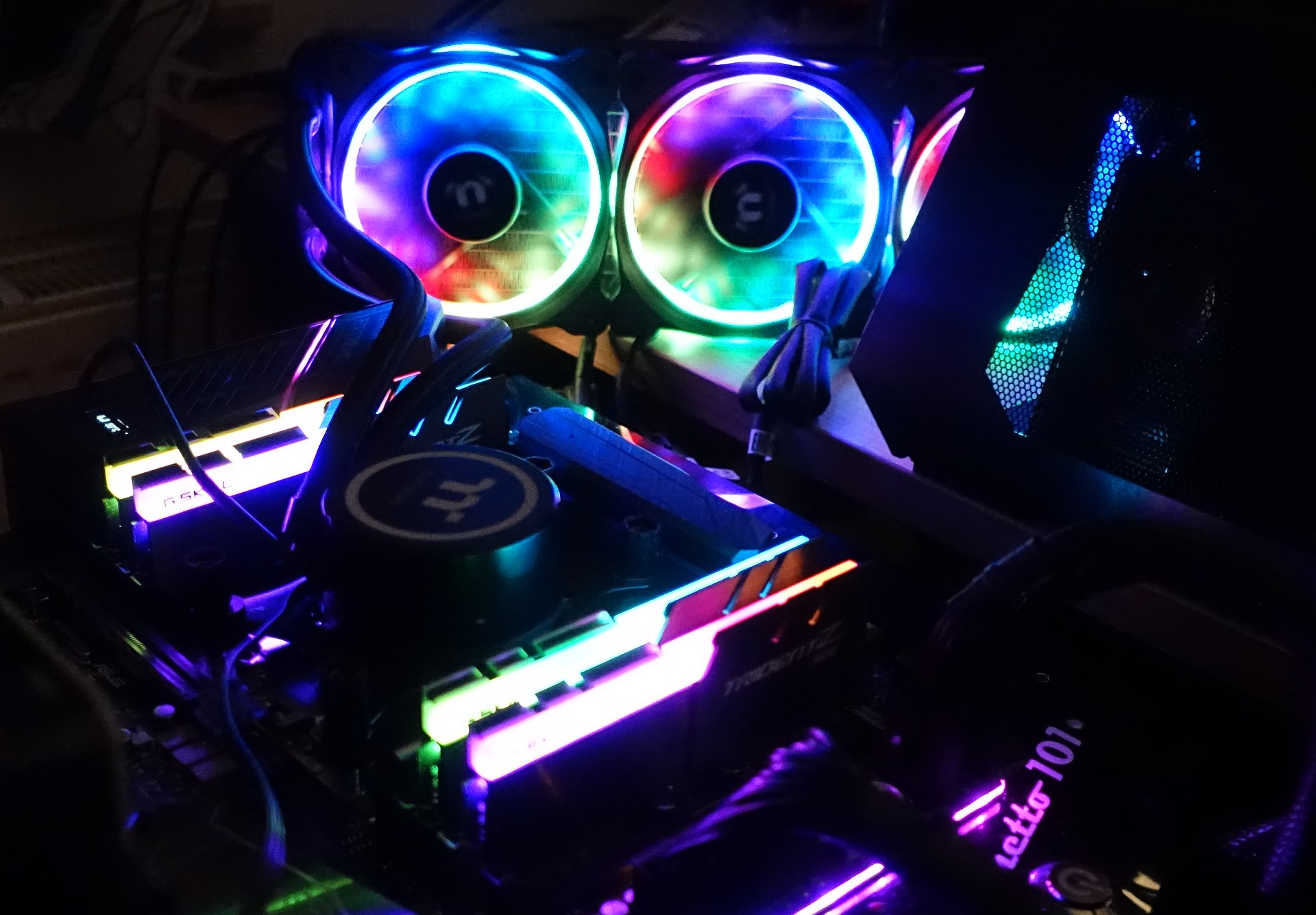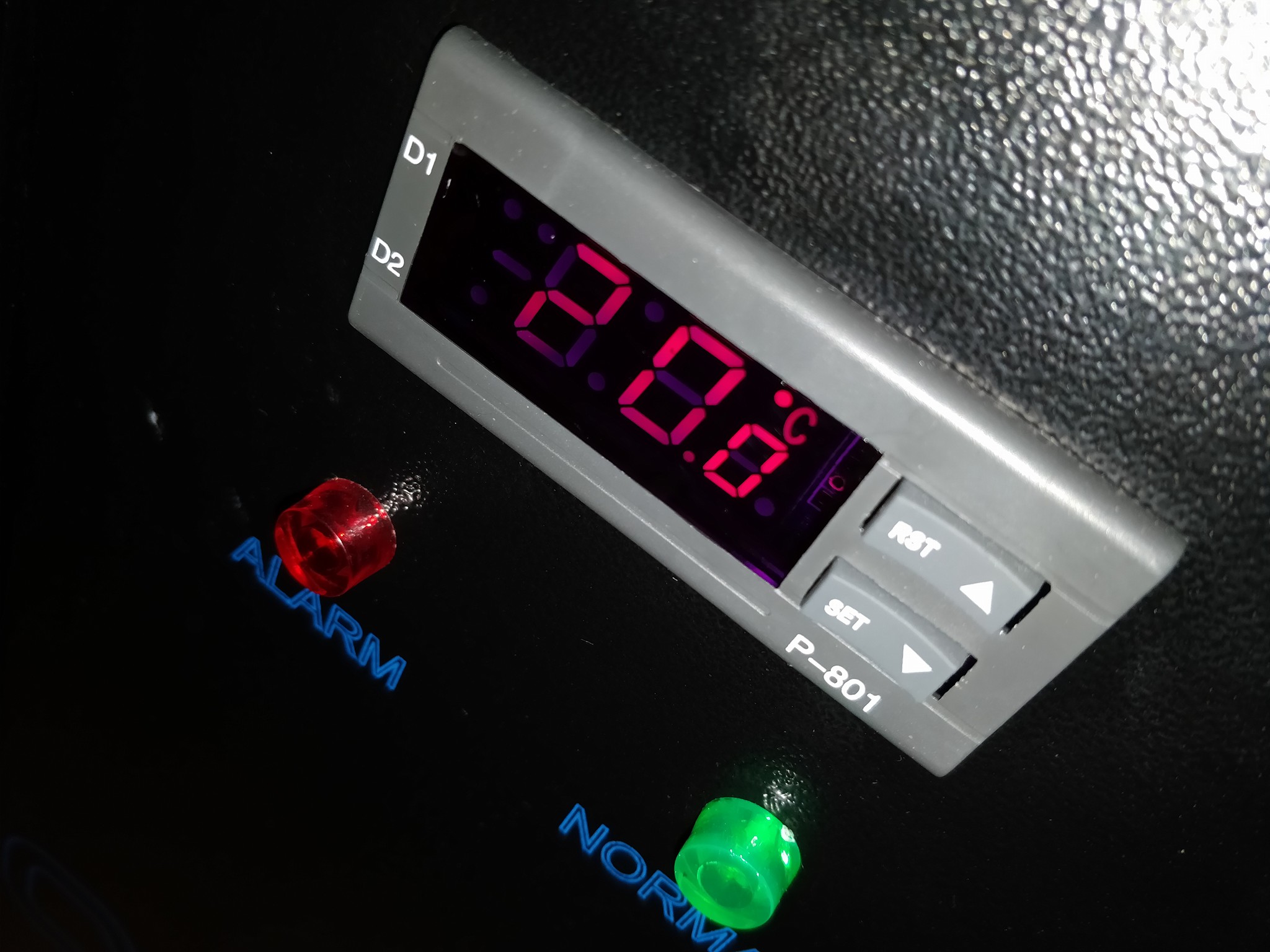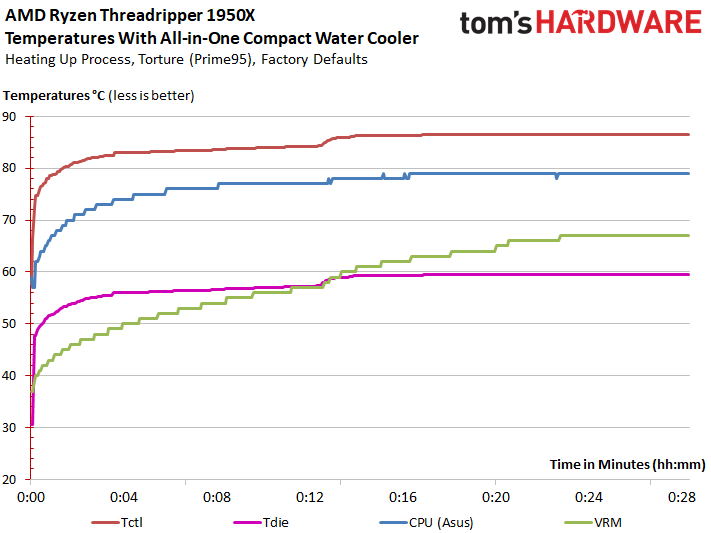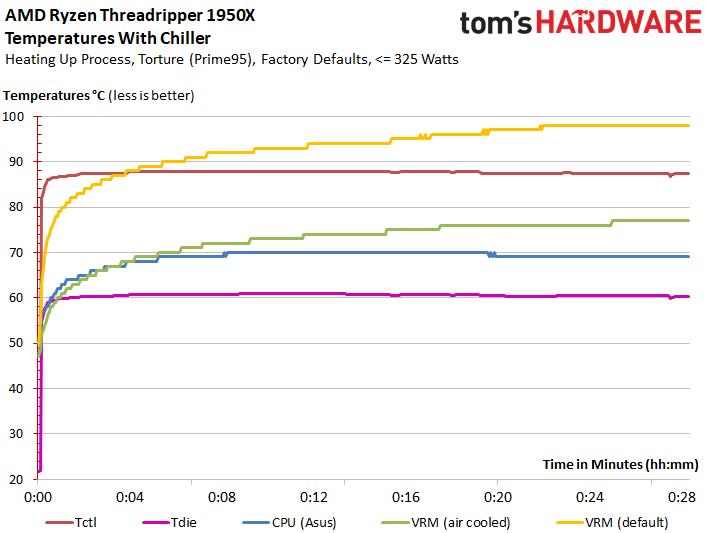AMD Ryzen Threadripper 1950X Review
Why you can trust Tom's Hardware
Overclocking, Cooling & Temperature
The Right Cooling Solution
AMD doesn't use thermal paste between the Ryzen Threadripper processors’ dies and integrated heat spreader. Instead, it went with good old solder. This decision should prove critical during our overclocking efforts.
Most reviewers (us included) received all-in-one liquid coolers for their Threadripper CPUs. They're made by Thermaltake and include a flat 360mm radiator with three 120mm fans.
Fully assembled, and sitting next to the motherboard and RGB-lit memory sticks, the whole kit lights up like a Christmas tree. At least it was (almost) fully functional. The only exception was the original thermal paste on Asetek's pump. There was simply not enough of it. Even without overclocking, AMD’s new processor can hit 180W under heavy load, and its heat spreader is relatively large. This combination requires a different approach. Instead of the usual centered blob, we drew a thick line with the thermal paste. We then put the pump in place and gently rotated it back and forth while manually applying some pressure. Only then did we screw it in place.
Installing Your Own Water Cooler
We’ve already reported how AMD changed its interface for Socket TR4 (SP3r2). One of the most important alterations involves the screws. AMD went with M3.5 screws, an uncommon size with a fine thread. You won’t find these at your local hardware store. The difference can easily be spotted in the picture below, with our purchase on the left and an original AM4 screw on the right:
Simply shipping brackets of a different size won’t do the trick here. The acquisition of suitable screws is also necessary. The socket’s threads don’t go all the way through, which is to say that they aren’t open in the back. So, the screws also need to be of the correct length. We tried 20mm screws, and they turned out to be too long. Then we experimented with fitting spacers. A good length for the screws would have been 15mm, but this might vary depending on the bracket’s thickness.
The next question, which is even more important than the first one, is how much pressure to apply. We used a special torque wrench with very small steps and M3.5 screws with internal hexagonal threads, and started with a reasonable 0.1Nm. From approximately 0.25Nm, we couldn’t detect any further gains in cooling performance, so that's where we stopped. A sensible maximum pressure is approximately 0.35Nm.
The picture below shows our completely installed cooling solution. The CPU block’s an Alphacool XPX with a bracket for AMD’s Socket TR4 (SP3r2). The polyamide washers are used as spacers and take the place of springs. The top washers are made of steel to keep the head of the cylinder from boring into the much softer washer material during the CPU block’s installation.
Get Tom's Hardware's best news and in-depth reviews, straight to your inbox.
Overclocking
Our Ryzen Threadripper 1950X sample overclocked to 3.9 GHz and 1.35V. However, the all-in-one water cooling solution in our kit couldn’t keep the system stable at that level. This was due to the processors’ power consumption rising to more than 250W during rendering.
And so we went back to our Chiller to achieve some better comparisons. This way, there’s one true constant to our measurements: a water temperature of approximately 20°C, which can be held constant, even topping more than 300W of waste heat.
For everyday use, a normal water-cooling solution will definitely suffice thanks to the soldered heat spreader, which makes AMD’s processor much less of a challenge than Intel's Core i9-7900X. Our approach simply allows us a bit more sophistication in our overclocking endeavors.
Using the Chiller, AMD’s Ryzen Threadripper 1950X achieved 4 GHz at 1.45V. Just don't expect to see those results from your own overclock. Even the Chiller started to fall behind the CPU's thermal output as temperatures crept too high for comfort. This is why the processor is overclocked to more reasonable levels for our benchmarks, with Threadripper running at 3.9 GHz.
Maximum Temperatures: Stock Clock Rate
AMD circulated a 27°C addition to the Tctl values, which is supposed to amount to the average core temperature. This sounds about right to us after taking a look at the temperature difference between Tctl and Tdie (the latter being the chip temperature). Between this and the fact that a huge cooler made it practically impossible to conduct our own heat spreader measurements, we're forgoing the delta measurements you saw in our Ryzen 3, 5, and 7 reviews.
We stick with the water cooling solution that AMD provided for our first results. As a bit of a power consumption spoiler, the motherboard limits the two CPUs between 179 and 180W. This upper boundary can’t even be exceeded for short periods of time using normal motherboard settings.
Here are the temperature curves:
The CPU temperature values reported by HWInfo64 through Asus' separate sensor loop are between 6°C and 12°C lower than the Tctl values, and they rise more slowly. The voltage converter temperatures of just under 60°C, achieved without any additional cooling, are great.
Maximum Temperatures: Overclocked
Increasing voltages to guarantee stable operation pushes the processor well beyond its sweet spot. Consequently, power consumption goes through the roof. Operating well beyond 300W poses a challenge for any cooling solution. That's why we're using the Chiller. We did try a normal water-cooling loop though, resulting in the Tctl and Tdie values going up by ~10°C to 15°C. This is well within an acceptable range.
The overclocked 1950X peaks at a hefty 320 to 325W. Using the Chiller, this level of power consumption is accompanied by Tctl values of 87°C. That’s actually not as severe as it seems once the offset and Tdie values are taken into account. A real temperature of approximately 60°C serves as a great demonstration of why solder is superior to thermal paste. Intel's Core i9-7900X could have had so much potential if the company hadn't taken the easy way out.
Voltage Converter Temperatures
We’ll conduct a separate test with different loads and X399 motherboards in the future. As for the Asus X399 ROG Zenith, its voltage converters generally stay under 100°C without any additional air cooling, even as AMD's CPU consumes well over 300W.
Asus set its throttling temperature threshold to 105°C. Even a bit of airflow helps, though. This is demonstrated quite nicely by the temperature curves for the overclocked configuration above. The fan that’s installed right above the I/O shield doesn’t really have any effect, unless you count its unnecessarily high noise level. Asus should have done without this gimmick.
MORE: Best CPUs
MORE: Intel & AMD Processor Hierarchy
MORE: All CPUs Content
Current page: Overclocking, Cooling & Temperature
Prev Page Scientific & Engineering Computations, & HPC Performance Next Page Power Consumption
Paul Alcorn is the Editor-in-Chief for Tom's Hardware US. He also writes news and reviews on CPUs, storage, and enterprise hardware.
-
I just looked at gaming benchmark and stopped reading there because as i thought Intel CPUs are killing Thread Ripper in gaming. As far as content creation, naturally having 16/32 setup will be faster than Intel 10/20 but again do you really need more than 10/20 cores. I don't and i heavily use PC for gaming, programming, web design, video/audio encoding. Overall Intel 7900x is better value and all around CPU. But if you are just in gaming 7700k is just enough.Reply
Thanks for review, and hello x299 platform.
Gaming vs. Content Creation mode through Software is just another big NO NO to me knowing how crappy AMD software is. I assume the most people will keep it in Game Mode and leave it as it is.
I appreciate that AMD brought this CPU for $999 with so many cores, helps competition but again there is nothing to drool over here in my book. AMD didn't bring any significant performance bump core vs. core basis. In fact AMD single core performance still sucks which means when Intel releases 10+ core CPU it is going to fun to watch.
Two things i am interested the most is Coffee Lake product and IPC improvement there and possible price adjustment with Core i9.
-
Kai Dowin I'm truly impressed to see 16 Zen cores consuming as much power as only 10 Skylake-X ones. Bravo, AMD!Reply -
Reply20045233 said:I'm truly impressed to see 16 Zen cores consuming as much power as only 10 Skylake-X ones. Bravo, AMD!
I am not knowing that Intel is running higher frequency.
-
JamesSneed Reply20045197 said:I just looked at gaming benchmark and stopped reading there because as i thought Intel CPUs are killing Thread Ripper in gaming. As far as content creation, naturally having 16/32 setup will be faster than Intel 10/20 but again do you really need more than 10/20 cores. I don't and i heavily use PC for gaming, programming, web design, video/audio encoding. Overall Intel 7900x is better value and all around CPU. But if you are just in gaming 7700k is just enough.
Thanks for review, and hello x299 platform.
Gaming vs. Content Creation mode through Software is just another big NO NO to me knowing how crappy AMD software is.
I love Intel even more...all you have to do pop CPU in and shit works and it works well.
I guess if gaming is why you were reading the Threadripper review then you are right it isn't as good as Intel's offerings but did you honestly expect any other result? I don't know why reviewers even do gaming tests on any CPU over 8 cores as it is mostly pointless. If you are doing scientific, encoding, professional tasks in just about every use case that is multi threaded it is blowing away every Intel offering. Of course that may change once there are 12-18 core Intel parts. However spending $1000 for a CPU is a bargain for those than can use it and never in history could you get a 16 core consumer part with this type of multi-threaded performance.
-
Lyden Thank you for this review. I was seriously considering Threadripper. Looks like the 7700k is still the sensible choice for the price when gaming.Reply -
Kai Dowin @FREAK777POWER And delivering higher multi-threaded performance with these lower clocked cores. Do you know what that's called? Efficiency.Reply -
redgarl This chip is designed for heavy calculation multithreading, it is not made for gaming, however it is working well with 1440p and 2160p.Reply
By the way, who in their mind will buy a 16 core CPU and play at 1080p with a 1080 TI... seriously, these 1080p bench are a joke and don't represent reality...
"A standard or point of reference against which things may be compared." Oxford
1080p with 1080 TI with a 16 core processor is not a point of reference at all. -
Pompompaihn Who are you people that come here and <ModEdit> about gaming performance on these chips??Reply
Threadripper is the F250 of CPUs. It's not the fastest, but it's plenty fast for 99% of your tasks, and if you need to haul a 12,000 pound trailer it'll do that, too. This is for people who do a lot of WORK on their machine but also game on the side.
<Moderator Warning: Watch your language in these forums>






